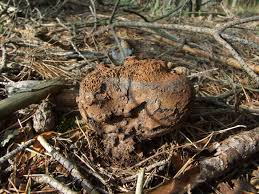
A few months ago, before the rainy season began, I was working at the Master Gardener help desk. A gentleman came into the office and handed me a sample of something that had been destroying his driveway and tennis court. Another Master Gardener who works at a local nursery had advised him to bring this sample to the help desk for information.
It was not a pretty sight. The nursery staffer had identified it as "dog poop fungus," albeit in less printable language. I took some information from the client and began a search. He said the fungus was growing right up through his driveway. I began perusing the books in our library to see what I could learn. Finally, I went to the computer and typed in the name the nursery staffer had given the specimen. To my surprise, several links came up.
In the meantime, other people had walked into the office and said, "Oh yes, that is growing in my lawn." My computer sources identified it as Pisolithustinctorius. Although it resembles a souvenir from a passing dog, this hard brown item is a true fungus. And as “tinctorius” suggests, it can be used to make a purple dye. Pisolithustinctorius is also called the dye maker's puffball and dog stinkhorn.
After talking with the county weed advisor and the Master Gardener program coordinator, I learned that the fungus grows in connection with tree roots, especially oak and elm. The fungus itself lives underground with the live or decaying tree roots. It is considered a mycorrhizal fungus because the tree roots and the fungus exchange nutrients and water.
Apparently the driveway and tennis court had been constructed in a former treesite. Tree roots were still in the soil. Mycorrhizae can survive in soil even if the tree roots have decayed. You can see the mycorrhizae if you are repotting a pine tree such as a bonsai. Always try to transplant some of the mycorrhizae to the new location. In pine soil, mycorrhizae appear as a white, web-like material.
The above-ground part, the mushroom, is the fruiting
body. It carries the spores that, when dispersed, will produce fungi in new homes. The part below ground is much bigger. According to the Bay Area Mycological Society, ourwarm, dry fall days encourage the fruiting bodies of Pisolithustinctoriusto appear.
Many fungus and their fruiting bodies need damp conditions to grow and reproduce. They thrive on decaying materials such as leaf litter, downed limbs and compost piles. In these settings,mushrooms will mature and open to release their spores. The fruiting bodies of Pisolithustinctorius are poisonous and certainly not appetizing.A fungicide will eliminate the fruiting bodies but not the underground fungi; when conditions are right, they will fruit again.
In the past, I had thought of mushrooms only as a delicious ingredient. But my reading revealed that the fungus family is a large one, neither plant nor animal. Scientists refer to the “fungi kingdom,” a reflection of how diverse it is. Some fungi are beneficial and used for medicines such as penicillin, but others are toxic, even deadly. You can even buy mycorrhizae to improve your soil, but those are not Pisolithustinctorius. You can view a photo gallery of fungi at www.kingdomoffungi.com.
Now that the Master Gardener help desk has identified this homeowner's problem, we are waiting to hear from you with another challenge. Please bring any plant or insect samples in a sealed plastic bag.
Workshop: U. C. Master Gardeners of Napa County will host a workshop on “Rose Pruning and Maintenance” on Saturday, January 9, from 10 a.m. to noon, at the University of California Cooperative Extension office, 1710 Soscol Avenue, Napa. This workshop will feature demonstrations of proper pruning techniques. Master Gardeners will discuss types of roses, common rose diseases and routine maintenance. On-line registration (credit card only); Mail-in registration (check only).
Workshop: U. C. Master Gardeners of Napa County will host a workshop on “Fruit Tree Pruning and Care” on Saturday, January 16, from 9:30 a.m. to 2 p.m. The workshop includes a lecture session from 9:30 a.m. to 11:30 a.m. at the University of California Cooperative Extension office, 1710 Soscol Avenue, Napa. A hands-on session follows from 12:30 p.m. to 2 p.m. at Silverado Middle School, 1108 Coombsville Road, Napa. On-line registration (credit card only); Mail-in/Walk-in registration (cash or check only).
Master Gardeners are volunteers who help the University of California reach the gardening public with home gardening information. U. C. Master Gardeners of Napa County ( http://ucanr.org/ucmgnapa/) are available to answer gardening questions in person or by phone, Monday, Wednesday and Friday, 9 a.m. to Noon, at the U. C. Cooperative Extension office, 1710 Soscol Avenue, Suite 4, Napa, 707-253-4143, or from outside City of Napa toll-free at 877-279-3065. Or e-mail your garden questions by following the guidelines on our web site. Click on Napa, then on Have Garden Questions? Find us on Facebook under UC Master Gardeners of Napa County.